Abstract
Using a number of approaches we were unable to demonstrate a chemotactic response of Myxococcus xanthus to a variety of defined and complex materials. These data in addition to a number of prima facie arguments considerably reduce the likelihood that M. xanthus possesses a mechanism for chemotactic behavior.
Full text
PDF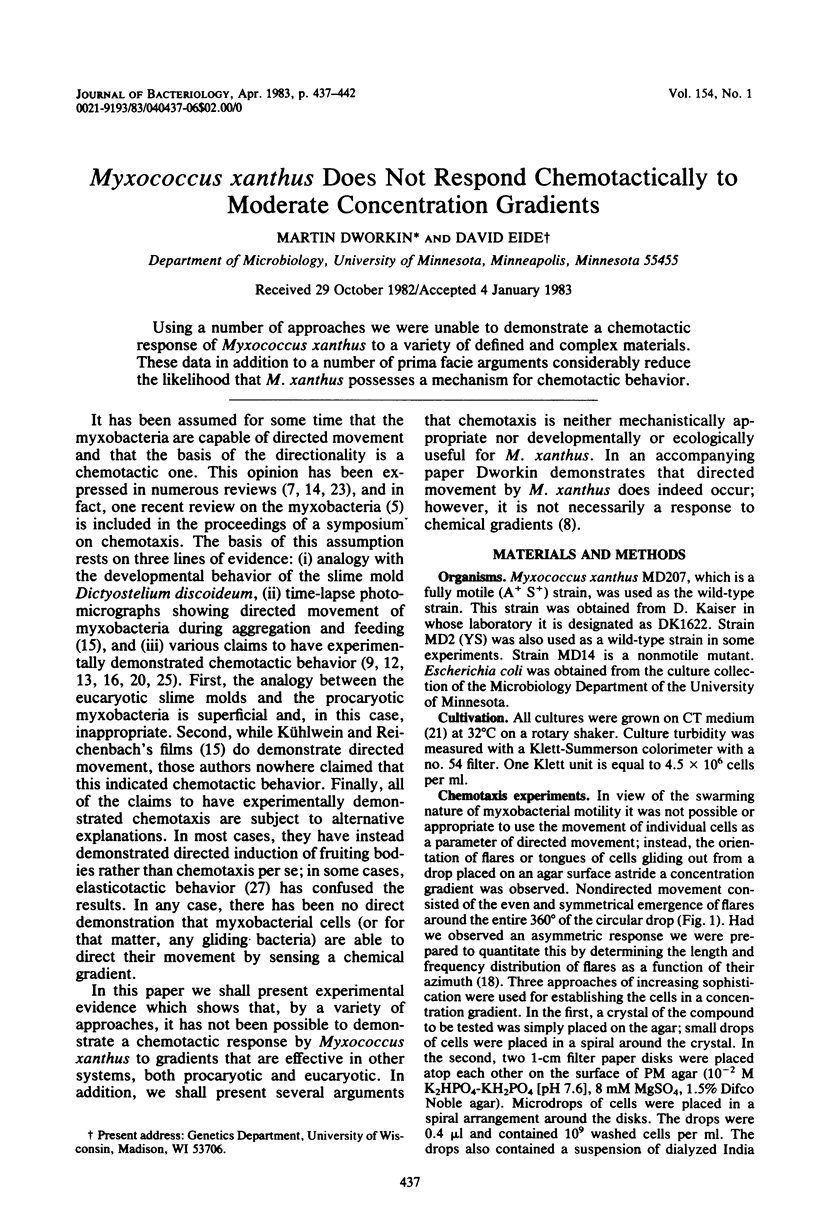
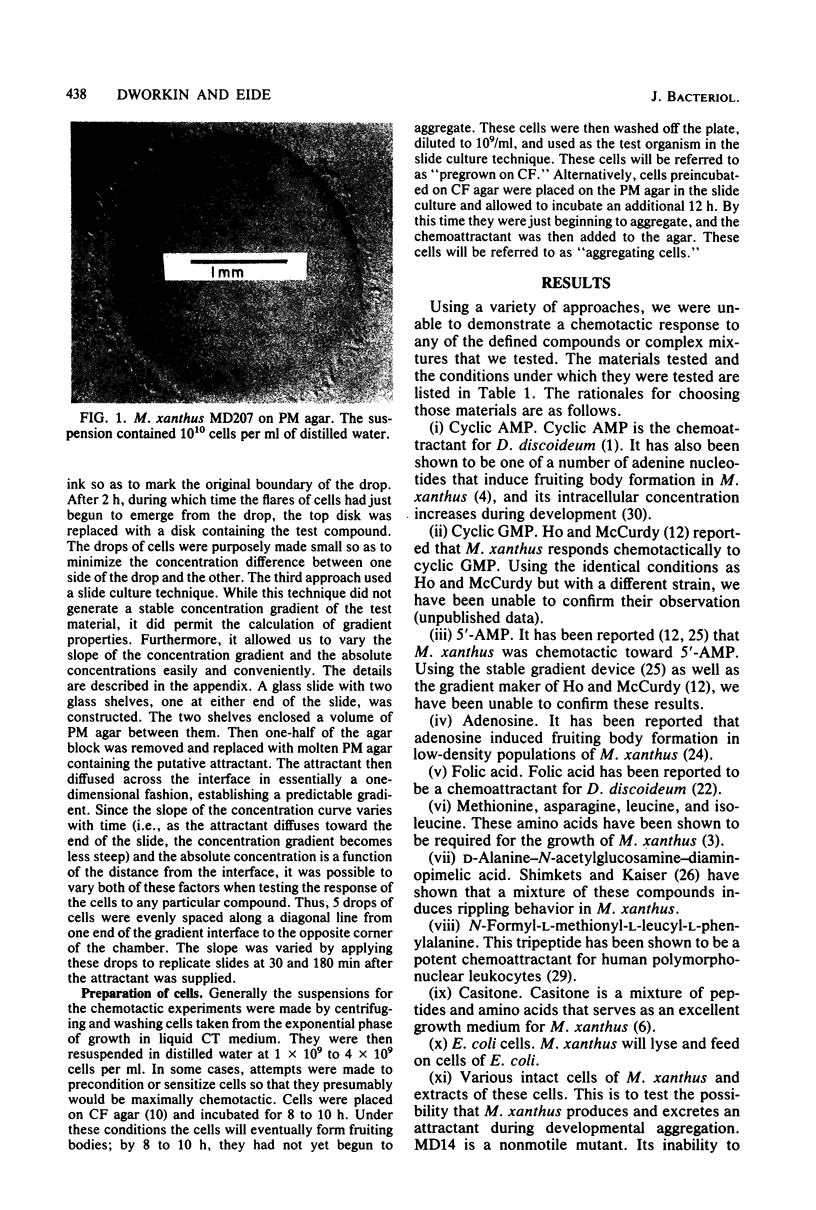
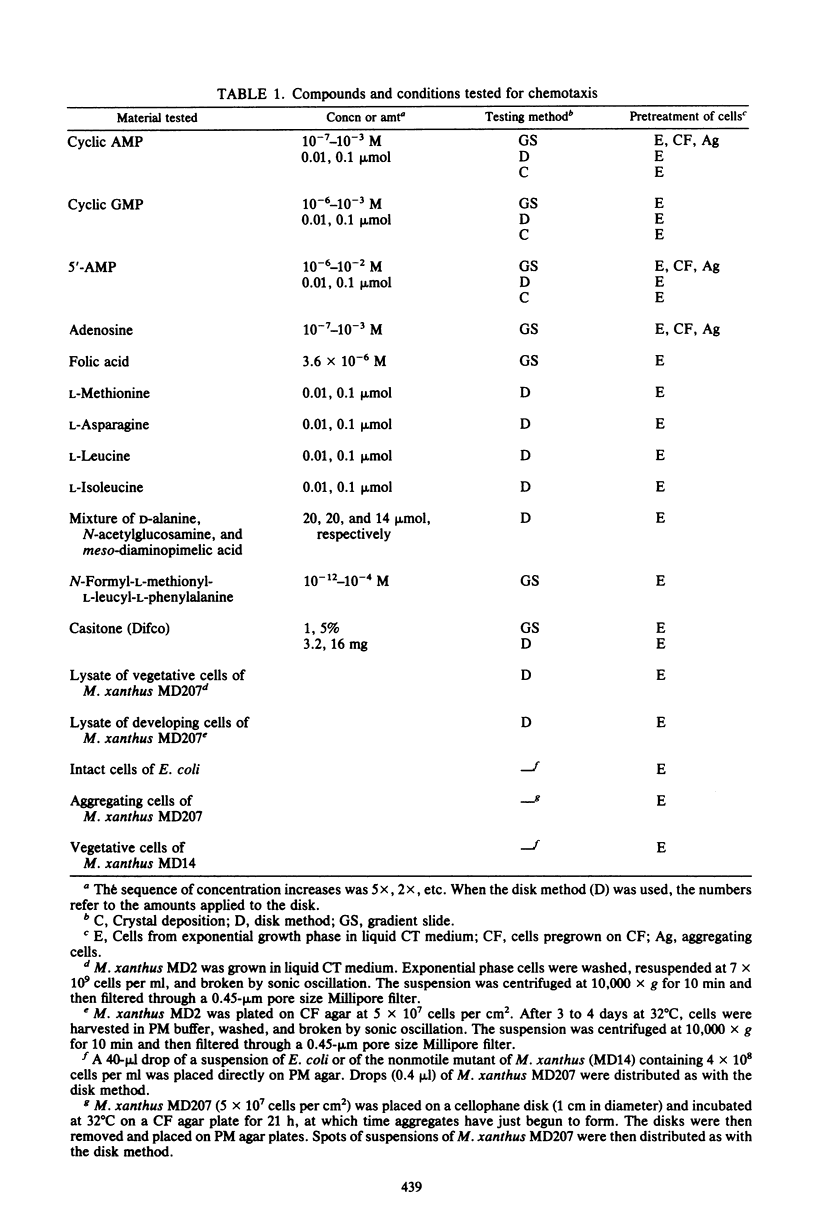
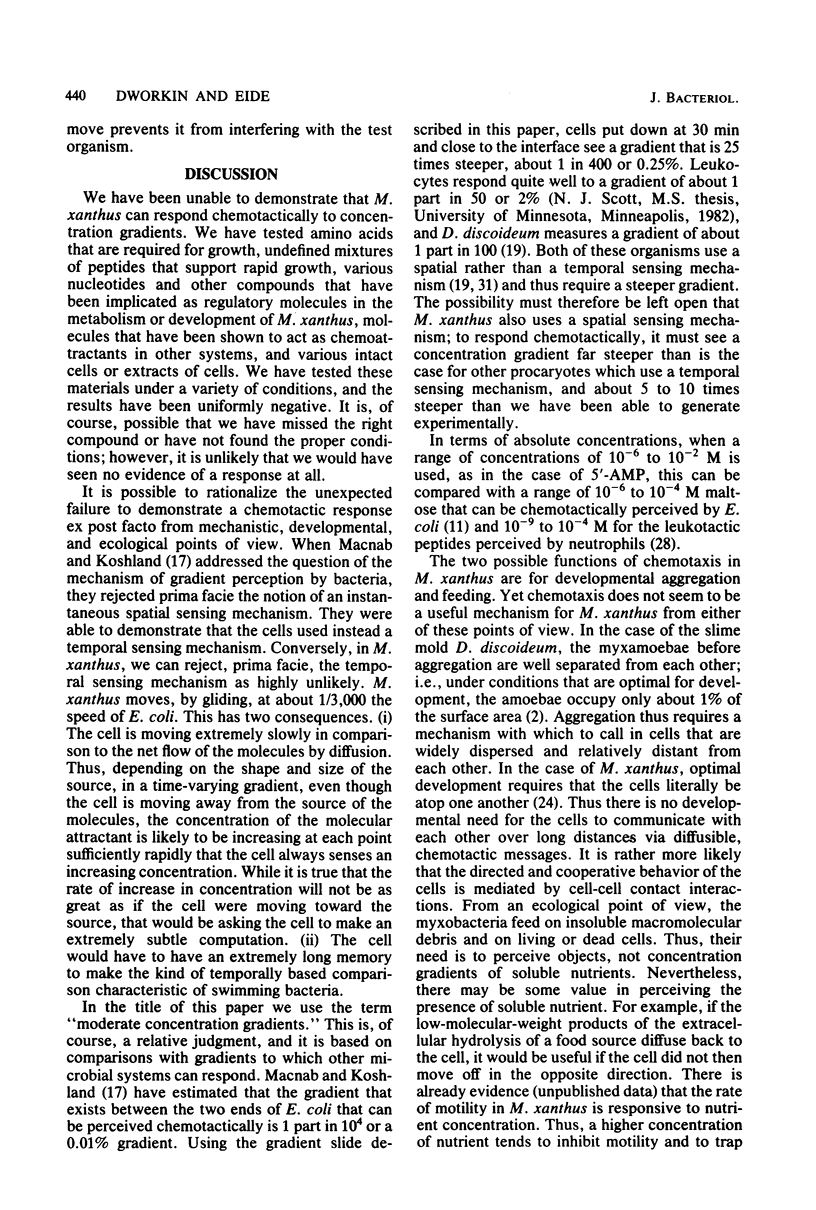
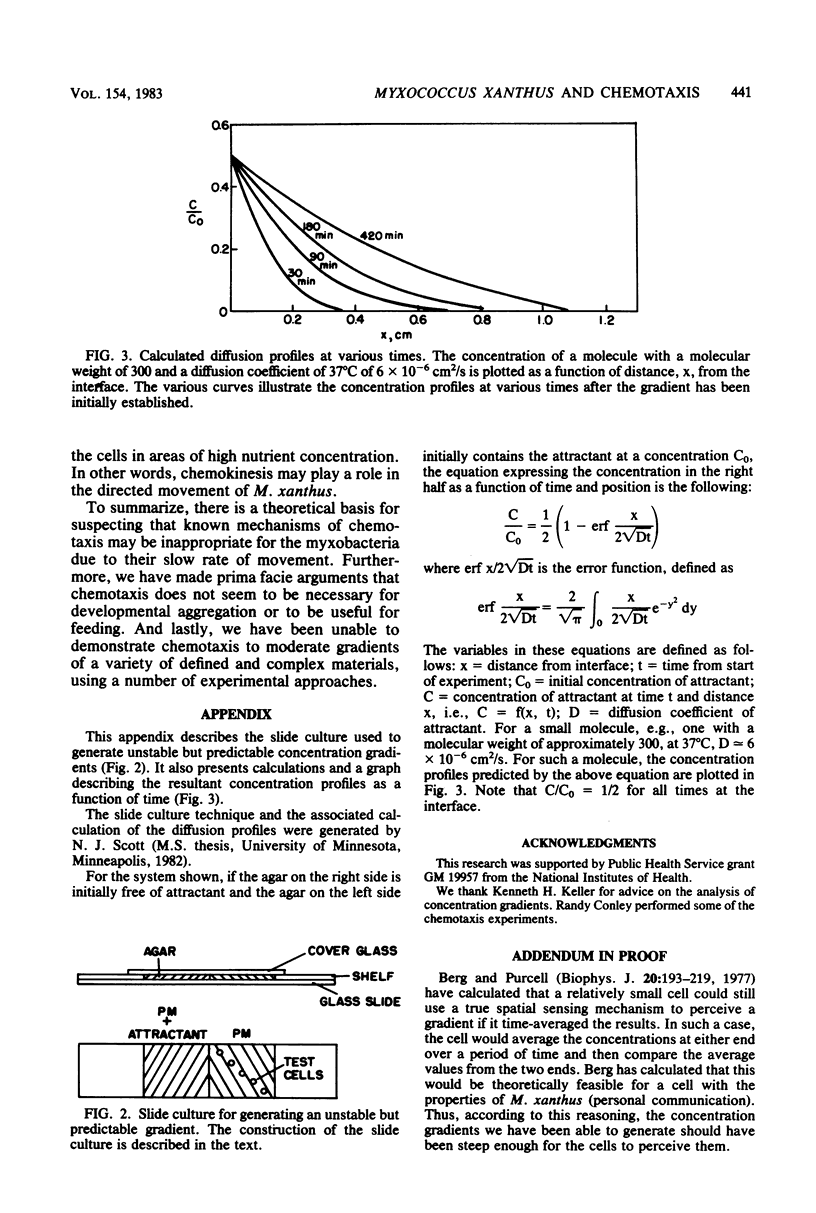
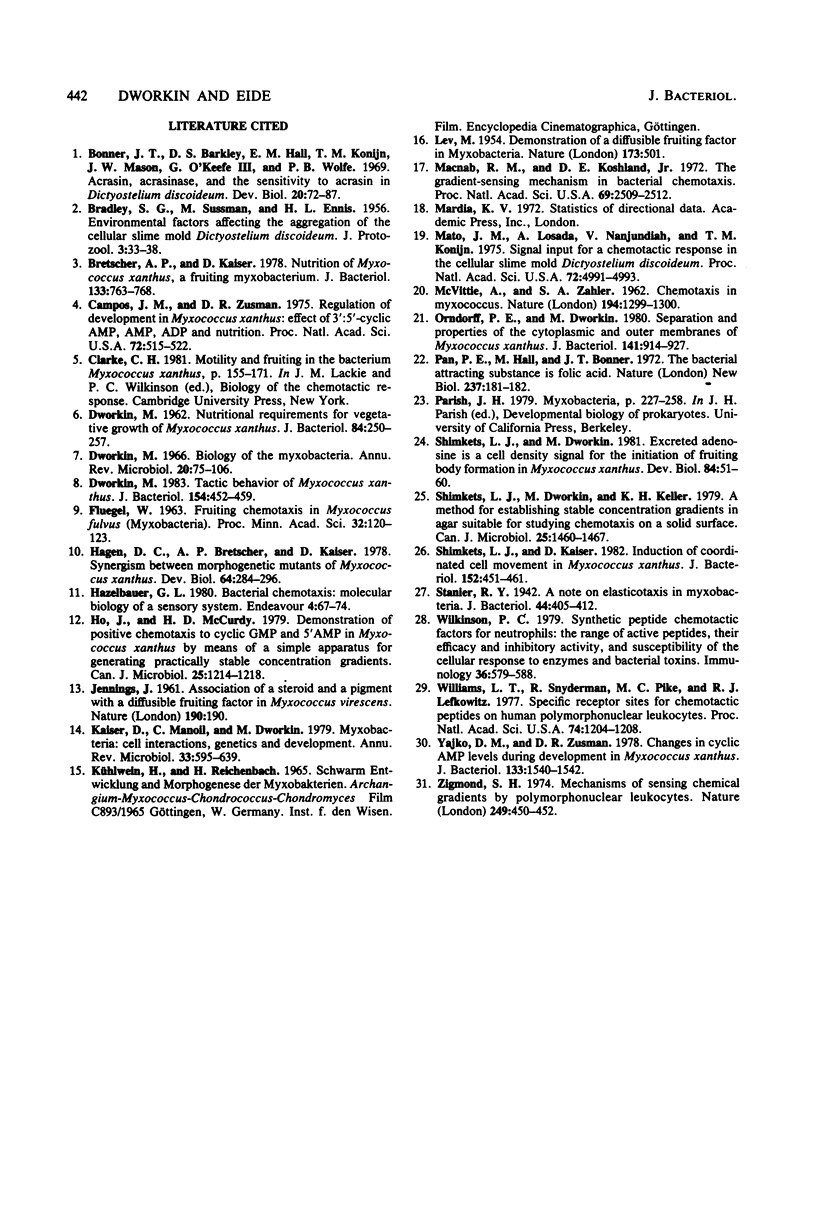
Images in this article
Selected References
These references are in PubMed. This may not be the complete list of references from this article.
- Berg H. C., Purcell E. M. Physics of chemoreception. Biophys J. 1977 Nov;20(2):193–219. doi: 10.1016/S0006-3495(77)85544-6. [DOI] [PMC free article] [PubMed] [Google Scholar]
- Bonner J. T., Barkley D. S., Hall E. M., Konijn T. M., Mason J. W., O'Keefe G., 3rd, Wolfe P. B. Acrasin, Acrasinase, and the sensitivity to acrasin in Dictyostelium discoideum. Dev Biol. 1969 Jul;20(1):72–87. doi: 10.1016/0012-1606(69)90005-0. [DOI] [PubMed] [Google Scholar]
- Bretscher A. P., Kaiser D. Nutrition of Myxococcus xanthus, a fruiting myxobacterium. J Bacteriol. 1978 Feb;133(2):763–768. doi: 10.1128/jb.133.2.763-768.1978. [DOI] [PMC free article] [PubMed] [Google Scholar]
- Campos J. M., Zusman D. R. Regulation of development in Myxococcus xanthus: effect of 3':5'-cyclic AMP, ADP, and nutrition. Proc Natl Acad Sci U S A. 1975 Feb;72(2):518–522. doi: 10.1073/pnas.72.2.518. [DOI] [PMC free article] [PubMed] [Google Scholar]
- DWORKIN M. Nutritional requirements for vegetative growth of Myxococcus xanthus. J Bacteriol. 1962 Aug;84:250–257. doi: 10.1128/jb.84.2.250-257.1962. [DOI] [PMC free article] [PubMed] [Google Scholar]
- Dworkin M. Biology of the myxobacteria. Annu Rev Microbiol. 1966;20:75–106. doi: 10.1146/annurev.mi.20.100166.000451. [DOI] [PubMed] [Google Scholar]
- Dworkin M. Tactic behavior of Myxococcus xanthus. J Bacteriol. 1983 Apr;154(1):452–459. doi: 10.1128/jb.154.1.452-459.1983. [DOI] [PMC free article] [PubMed] [Google Scholar]
- Hagen D. C., Bretscher A. P., Kaiser D. Synergism between morphogenetic mutants of Myxococcus xanthus. Dev Biol. 1978 Jun;64(2):284–296. doi: 10.1016/0012-1606(78)90079-9. [DOI] [PubMed] [Google Scholar]
- Hazelbauer G. L. Bacterial chemotaxis: molecular biology of a sensory system. Endeavour. 1980;4(2):67–73. doi: 10.1016/0160-9327(80)90142-8. [DOI] [PubMed] [Google Scholar]
- Ho J., McCurdy H. D. Demonstration of positive chemotaxis to cyclic GMP and 5'-AMP in Myxococcus xanthus by means of a simple apparatus for generating practically stable concentration gradients. Can J Microbiol. 1979 Oct;25(10):1214–1218. doi: 10.1139/m79-191. [DOI] [PubMed] [Google Scholar]
- JENNINGS J. Association of a steroid and a pigment with a diffusible fruiting factor in Myxococcus virescens. Nature. 1961 Apr 8;190:190–190. doi: 10.1038/190190b0. [DOI] [PubMed] [Google Scholar]
- Kaiser D., Manoil C., Dworkin M. Myxobacteria: cell interactions, genetics, and development. Annu Rev Microbiol. 1979;33:595–639. doi: 10.1146/annurev.mi.33.100179.003115. [DOI] [PubMed] [Google Scholar]
- Macnab R. M., Koshland D. E., Jr The gradient-sensing mechanism in bacterial chemotaxis. Proc Natl Acad Sci U S A. 1972 Sep;69(9):2509–2512. doi: 10.1073/pnas.69.9.2509. [DOI] [PMC free article] [PubMed] [Google Scholar]
- Mato J. M., Losada A., Nanjundiah V., Konijn T. M. Signal input for a chemotactic response in the cellular slime mold Dictyostelium discoideum. Proc Natl Acad Sci U S A. 1975 Dec;72(12):4991–4993. doi: 10.1073/pnas.72.12.4991. [DOI] [PMC free article] [PubMed] [Google Scholar]
- Orndorff P. E., Dworkin M. Separation and properties of the cytoplasmic and outer membranes of vegetative cells of Myxococcus xanthus. J Bacteriol. 1980 Feb;141(2):914–927. doi: 10.1128/jb.141.2.914-927.1980. [DOI] [PMC free article] [PubMed] [Google Scholar]
- Pan P., Hall E. M., Bonner J. T. Folic acid as second chemotactic substance in the cellular slime moulds. Nat New Biol. 1972 Jun 7;237(75):181–182. doi: 10.1038/newbio237181a0. [DOI] [PubMed] [Google Scholar]
- Shimkets L. J., Dworkin M. Excreted adenosine is a cell density signal for the initiation of fruiting body formation in Myxococcus xanthus. Dev Biol. 1981 May;84(1):51–60. doi: 10.1016/0012-1606(81)90369-9. [DOI] [PubMed] [Google Scholar]
- Shimkets L. J., Dworkin M., Keller K. H. A method for establishing stable concentration gradients in agar suitable for studying chemotaxis on a solid surface. Can J Microbiol. 1979 Dec;25(12):1460–1467. doi: 10.1139/m79-226. [DOI] [PubMed] [Google Scholar]
- Shimkets L. J., Kaiser D. Induction of coordinated movement of Myxococcus xanthus cells. J Bacteriol. 1982 Oct;152(1):451–461. doi: 10.1128/jb.152.1.451-461.1982. [DOI] [PMC free article] [PubMed] [Google Scholar]
- Stanier R. Y. A Note on Elasticotaxis in Myxobacteria. J Bacteriol. 1942 Oct;44(4):405–412. doi: 10.1128/jb.44.4.405-412.1942. [DOI] [PMC free article] [PubMed] [Google Scholar]
- WOLFF S. Delay of chromosome rejoining in Vicia faba induced by irradiation. Nature. 1954 Mar 13;173(4402):501–502. doi: 10.1038/173501b0. [DOI] [PubMed] [Google Scholar]
- Wilkinson P. C. Synthetic peptide chemotactic factors for neutrophils: the range of active peptides, their efficacy and inhibitory activity, and susceptibility of the cellular response to enzymes and bacterial toxins. Immunology. 1979 Mar;36(3):579–588. [PMC free article] [PubMed] [Google Scholar]
- Williams L. T., Snyderman R., Pike M. C., Lefkowitz R. J. Specific receptor sites for chemotactic peptides on human polymorphonuclear leukocytes. Proc Natl Acad Sci U S A. 1977 Mar;74(3):1204–1208. doi: 10.1073/pnas.74.3.1204. [DOI] [PMC free article] [PubMed] [Google Scholar]
- Yajko D. M., Zusman D. R. Changes in cyclic AMP levels during development in Myxococcus xanthus. J Bacteriol. 1978 Mar;133(3):1540–1542. doi: 10.1128/jb.133.3.1540-1542.1978. [DOI] [PMC free article] [PubMed] [Google Scholar]
- Zigmond S. H. Mechanisms of sensing chemical gradients by polymorphonuclear leukocytes. Nature. 1974 May 31;249(456):450–452. doi: 10.1038/249450a0. [DOI] [PubMed] [Google Scholar]



